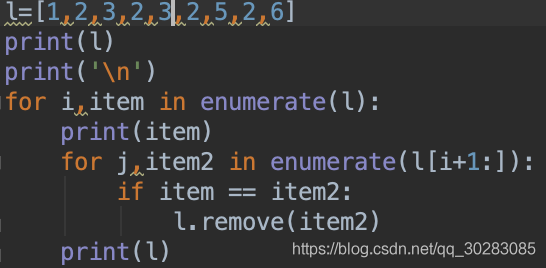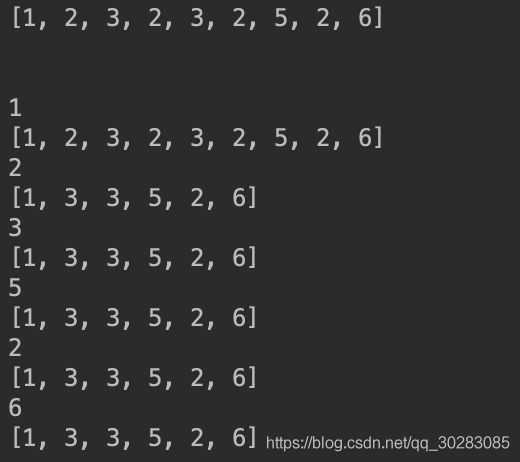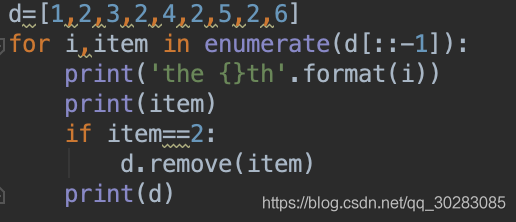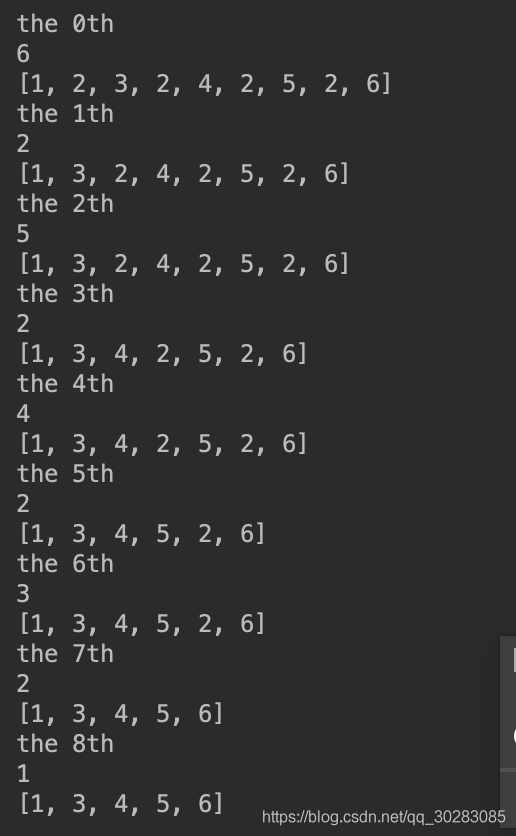本篇文章为大家展示了使用Python怎么删除列表重复元素,内容简明扼要并且容易理解,绝对能使你眼前一亮,通过这篇文章的详细介绍希望你能有所收获。
python常用的库:1.requesuts;2.scrapy;3.pillow;4.twisted;5.numpy;6.matplotlib;7.pygama;8.ipyhton等。
一.如果已经有了一个列表l,令h=l,对l操作时同时会影响h,貌似原因是内存共享的,正确的方法是h=l.copy()
二.测试时,发现一个问题,如下面代码和结果:


item=2时,并没有把2全部删掉,后面重复的3也没有删去。
**查阅一些资料后发现:list的遍历是基于下标的不是基于元素,你删掉一个元素后,列表就发生了变化,所有的元素都往前移动了一个位置,假设要删除重的2,一个列表中索引为4,对应的值为2,索引为5,对应的值为2,索引为6,对应的值为3,当前循环删掉索引4时对应的值2之后,索引4的值为2,索引5,值为3,下一次循环,本来要再删一个2,但此时索引为5对应的为3,就漏掉了一个2。
(1)倒序循环遍历:


(2)实际用的方法,判断到重复元素后,将那个item复制为0或‘0',相当于用一个标识符占住重复元素的位置,循环时先判断是否为‘0',最后通过
list = list(set(list))
list.remove('0')
即可
附图像去冗余算法,判断图像相似通过,感知哈希算法和三通道直方图,及图像尺寸
from img_similarity import runtwoImageSimilaryFun
import os
from PIL import Image
import shutil
import time
import numpy as np
def similar(path2, path3):
img1 = Image.open(path2)
img2 = Image.open(path3)
w1 = img1.size[0] # 图片的宽
h2 = img2.size[1] # 图片的高
w2 = img2.size[0] # 图片的宽
h3 = img2.size[1] # 图片的高
w_err = abs(w1 - w2)/w1
h_err = abs(h2 - h3)/h2
if w_err > 0.1 or h_err >0.1:
return 0
else:
phash, color_hist = runtwoImageSimilaryFun(path2, path3)
if phash <=8 or color_hist >=0.9:
return 1
else:
return 0
path = './crop_img'
result_imgdirs_path = './removed_repeat_img'
folderlist = os.listdir(path)
folderlist.sort()
for item in folderlist:
folder_path = path + '/' + item
new_folder_path = result_imgdirs_path + '/' + item
os.makedirs(new_folder_path)
imglist = os.listdir(folder_path)
imglist.sort()
time_start = time.time()
for i,item1 in enumerate(imglist):
if item1 == '0':
continue
path2 = folder_path + '/' + item1
for j, item2 in enumerate(imglist[i + 1:]):
if item2 == '0':
continue
path3 = folder_path + '/' + item2
t = similar(path2, path3)
if t:
#将判断为相似的图片在trans_list中的名字置‘0',代表不需要复制
imglist[i+j+1] = '0'
imglist = list(set(imglist))
imglist.remove('0')
time_end = time.time()
time_c = time_end - time_start
print('{} similarity judgement list time cost {}s'.format(item, time_c))
time_start = time.time()
#移动图片
for item3 in imglist:
ori_img_path = folder_path + '/' + item3
new_img_path = new_folder_path + '/' + item3
shutil.copy(ori_img_path, new_img_path)
time_end = time.time()
time_c = time_end - time_start # 运行所花时间
print('{} move image time cost {}s'.format(item, time_c))img_similarity.py
import cv2
import numpy as np
from PIL import Image
import requests
from io import BytesIO
import matplotlib
matplotlib.use('TkAgg')
import matplotlib.pyplot as plt
def aHash(img):
# 均值哈希算法
# 缩放为8*8
img = cv2.resize(img, (8, 8))
# 转换为灰度图
gray = cv2.cvtColor(img, cv2.COLOR_BGR2GRAY)
# s为像素和初值为0,hash_str为hash值初值为''
s = 0
hash_str = ''
# 遍历累加求像素和
for i in range(8):
for j in range(8):
s = s + gray[i, j]
# 求平均灰度
avg = s / 64
# 灰度大于平均值为1相反为0生成图片的hash值
for i in range(8):
for j in range(8):
if gray[i, j] > avg:
hash_str = hash_str + '1'
else:
hash_str = hash_str + '0'
return hash_str
def dHash(img):
# 差值哈希算法
# 缩放8*8
img = cv2.resize(img, (9, 8))
# 转换灰度图
gray = cv2.cvtColor(img, cv2.COLOR_BGR2GRAY)
hash_str = ''
# 每行前一个像素大于后一个像素为1,相反为0,生成哈希
for i in range(8):
for j in range(8):
if gray[i, j] > gray[i, j + 1]:
hash_str = hash_str + '1'
else:
hash_str = hash_str + '0'
return hash_str
def pHash(img):
# 感知哈希算法
# 缩放32*32
img = cv2.resize(img, (32, 32)) # , interpolation=cv2.INTER_CUBIC
# 转换为灰度图
gray = cv2.cvtColor(img, cv2.COLOR_BGR2GRAY)
# 将灰度图转为浮点型,再进行dct变换
dct = cv2.dct(np.float32(gray))
# opencv实现的掩码操作
dct_roi = dct[0:8, 0:8]
hash = []
avreage = np.mean(dct_roi)
for i in range(dct_roi.shape[0]):
for j in range(dct_roi.shape[1]):
if dct_roi[i, j] > avreage:
hash.append(1)
else:
hash.append(0)
return hash
def calculate(image1, image2):
# 灰度直方图算法
# 计算单通道的直方图的相似值
hist1 = cv2.calcHist([image1], [0], None, [256], [0.0, 255.0])
hist2 = cv2.calcHist([image2], [0], None, [256], [0.0, 255.0])
# 计算直方图的重合度
degree = 0
for i in range(len(hist1)):
if hist1[i] != hist2[i]:
degree = degree + \
(1 - abs(hist1[i] - hist2[i]) / max(hist1[i], hist2[i]))
else:
degree = degree + 1
degree = degree / len(hist1)
return degree
def classify_hist_with_split(image1, image2, size=(256, 256)):
# RGB每个通道的直方图相似度
# 将图像resize后,分离为RGB三个通道,再计算每个通道的相似值
image1 = cv2.resize(image1, size)
image2 = cv2.resize(image2, size)
sub_image1 = cv2.split(image1)
sub_image2 = cv2.split(image2)
sub_data = 0
for im1, im2 in zip(sub_image1, sub_image2):
sub_data += calculate(im1, im2)
sub_data = sub_data / 3
return sub_data
def cmpHash(hash2, hash3):
# Hash值对比
# 算法中1和0顺序组合起来的即是图片的指纹hash。顺序不固定,但是比较的时候必须是相同的顺序。
# 对比两幅图的指纹,计算汉明距离,即两个64位的hash值有多少是不一样的,不同的位数越小,图片越相似
# 汉明距离:一组二进制数据变成另一组数据所需要的步骤,可以衡量两图的差异,汉明距离越小,则相似度越高。汉明距离为0,即两张图片完全一样
n = 0
# hash长度不同则返回-1代表传参出错
if len(hash2) != len(hash3):
return -1
# 遍历判断
for i in range(len(hash2)):
# 不相等则n计数+1,n最终为相似度
if hash2[i] != hash3[i]:
n = n + 1
return n
def getImageByUrl(url):
# 根据图片url 获取图片对象
html = requests.get(url, verify=False)
image = Image.open(BytesIO(html.content))
return image
def PILImageToCV():
# PIL Image转换成OpenCV格式
path = "/Users/waldenz/Documents/Work/doc/TestImages/t3.png"
img = Image.open(path)
plt.subplot(121)
plt.imshow(img)
print(isinstance(img, np.ndarray))
img = cv2.cvtColor(np.asarray(img), cv2.COLOR_RGB2BGR)
print(isinstance(img, np.ndarray))
plt.subplot(122)
plt.imshow(img)
plt.show()
def CVImageToPIL():
# OpenCV图片转换为PIL image
path = "/Users/waldenz/Documents/Work/doc/TestImages/t3.png"
img = cv2.imread(path)
# cv2.imshow("OpenCV",img)
plt.subplot(121)
plt.imshow(img)
img2 = Image.fromarray(cv2.cvtColor(img, cv2.COLOR_BGR2RGB))
plt.subplot(122)
plt.imshow(img2)
plt.show()
def bytes_to_cvimage(filebytes):
# 图片字节流转换为cv image
image = Image.open(filebytes)
img = cv2.cvtColor(np.asarray(image), cv2.COLOR_RGB2BGR)
return img
def runAllImageSimilaryFun(para1, para2):
# 均值、差值、感知哈希算法三种算法值越小,则越相似,相同图片值为0
# 三直方图算法和单通道的直方图 0-1之间,值越大,越相似。 相同图片为1
# t1,t2 14;19;10; 0.70;0.75
# t1,t3 39 33 18 0.58 0.49
# s1,s2 7 23 11 0.83 0.86 挺相似的图片
# c1,c2 11 29 17 0.30 0.31
if para1.startswith("http"):
# 根据链接下载图片,并转换为opencv格式
img1 = getImageByUrl(para1)
img1 = cv2.cvtColor(np.asarray(img1), cv2.COLOR_RGB2BGR)
img2 = getImageByUrl(para2)
img2 = cv2.cvtColor(np.asarray(img2), cv2.COLOR_RGB2BGR)
else:
# 通过imread方法直接读取物理路径
img1 = cv2.imread(para1)
img2 = cv2.imread(para2)
hash2 = aHash(img1)
hash3 = aHash(img2)
n1 = cmpHash(hash2, hash3)
print('均值哈希算法相似度aHash:', n1)
hash2 = dHash(img1)
hash3 = dHash(img2)
n2 = cmpHash(hash2, hash3)
print('差值哈希算法相似度dHash:', n2)
hash2 = pHash(img1)
hash3 = pHash(img2)
n3 = cmpHash(hash2, hash3)
print('感知哈希算法相似度pHash:', n3)
n4 = classify_hist_with_split(img1, img2)
print('三直方图算法相似度:', n4)
n5 = calculate(img1, img2)
print("单通道的直方图", n5)
print("%d %d %d %.2f %.2f " % (n1, n2, n3, round(n4[0], 2), n5[0]))
print("%.2f %.2f %.2f %.2f %.2f " % (1 - float(n1 / 64), 1 -
float(n2 / 64), 1 - float(n3 / 64), round(n4[0], 2), n5[0]))
plt.subplot(121)
plt.imshow(Image.fromarray(cv2.cvtColor(img1, cv2.COLOR_BGR2RGB)))
plt.subplot(122)
plt.imshow(Image.fromarray(cv2.cvtColor(img2, cv2.COLOR_BGR2RGB)))
plt.show()
def runtwoImageSimilaryFun(para1, para2):
# 均值、差值、感知哈希算法三种算法值越小,则越相似,相同图片值为0
# 三直方图算法和单通道的直方图 0-1之间,值越大,越相似。 相同图片为1
# t1,t2 14;19;10; 0.70;0.75
# t1,t3 39 33 18 0.58 0.49
# s1,s2 7 23 11 0.83 0.86 挺相似的图片
# c1,c2 11 29 17 0.30 0.31
if para1.startswith("http"):
# 根据链接下载图片,并转换为opencv格式
img1 = getImageByUrl(para1)
img1 = cv2.cvtColor(np.asarray(img1), cv2.COLOR_RGB2BGR)
img2 = getImageByUrl(para2)
img2 = cv2.cvtColor(np.asarray(img2), cv2.COLOR_RGB2BGR)
else:
# 通过imread方法直接读取物理路径
img1 = cv2.imread(para1)
img2 = cv2.imread(para2)
hash2 = pHash(img1)
hash3 = pHash(img2)
n3 = cmpHash(hash2, hash3)
n4 = classify_hist_with_split(img1, img2)
return n3, n4
if __name__ == "__main__":
p1 = '/Users/Desktop/11/24.jpeg'
p2 = '/Users/Desktop/11/25.jpeg'
runAllImageSimilaryFun(p1, p2)上述内容就是使用Python怎么删除列表重复元素,你们学到知识或技能了吗?如果还想学到更多技能或者丰富自己的知识储备,欢迎关注亿速云行业资讯频道。
免责声明:本站发布的内容(图片、视频和文字)以原创、转载和分享为主,文章观点不代表本网站立场,如果涉及侵权请联系站长邮箱:is@yisu.com进行举报,并提供相关证据,一经查实,将立刻删除涉嫌侵权内容。